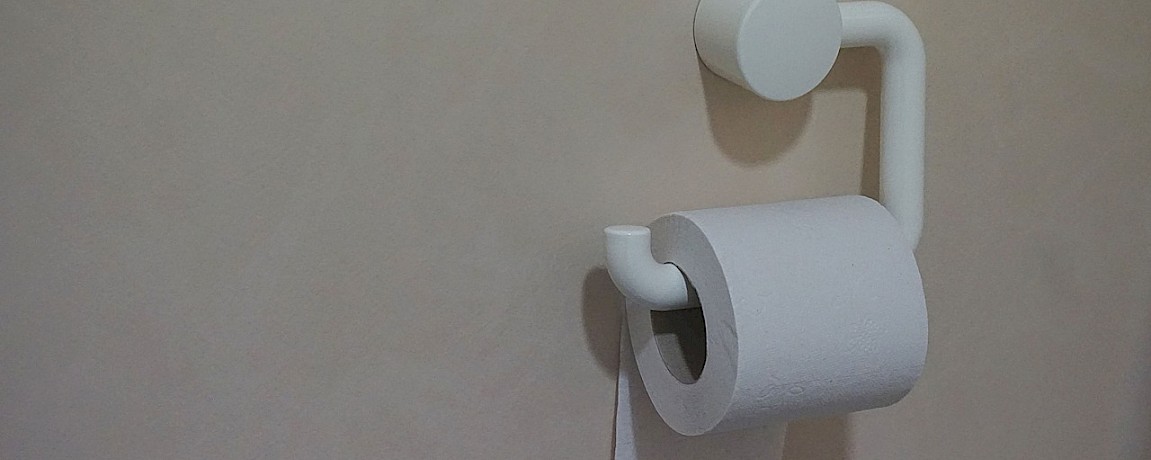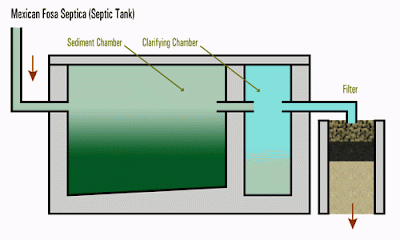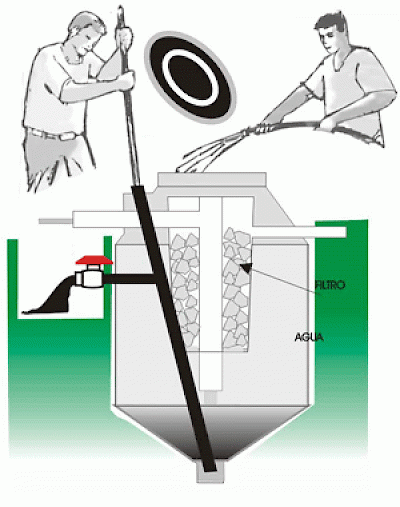Mexican Septic Systems
We promised to explain why you should not put paper in a Mexican toilet, and we’re not going to let you down. There are actually several answers to this question and the most puzzling of these is: you can put paper in a Mexican toilet! Yes, you can. The toilet will not spit the paper back out like a wrinkled dollar from a vending machine. The toilet police won’t show up at your door. And there will be no immediate ill effect from your indiscretion.
But it would be rude.
In many tourist destinations in Mexico, especially hotels, where modern sewage treatment is available, you are encouraged to flush your paper, just like in Gringolandia. The hotel management may even post little signs to let their Mexican guests know that they are expected to dispose of their papel confort down the toilet. They have to do this because Mexicans are trained from birth to be very polite.
But away from the tourist hangouts, and especially in private homes, you will encounter a small, covered, plastic or plastic-lined wastebasket near the toilet. If you see one, then be a polite guest and put your paper in there, not down the toilet.
To understand what etiquette has to do with how you dispose of toilet paper in Mexico, we need a basic understanding of sewer systems. If you are reading this from your home or office in Gringolandia, chances are that your toilet (and anything else that drains from your house) is connected to your city’s public sewer system. Everything you flush flows through large concrete pipes to an industrial processing plant where the solids are separated from the liquids. The liquids are filtered and treated with chemicals and the result is released back into the environment in the least offensive way possible where nature finishes the process using evaporation and rain. The solids are also treated and refined, resulting either in trash or fertilizer. This immense infrastructure is quite expensive to install, operate and maintain. It also consumes a lot of energy. These are your tax dollars at work.
Gringos who flush outside the city limits use a private septic tank, called a fosa septica (septic pit) or sumidero (drain) here in Mexico. In Gringolandia, a septic tank is usually made of a durable plastic and has two chambers, each with a pipe tee inside. The first is the sediment chamber, where the wastewater initially enters. User Plawerth explains the process neatly in his comment:
When waste enters the tank, the paper, poo, and any oils from bathing will float near the surface as a layer known as scum. Over time bacteria will consume nutrients in the scum, and it then settles on the bottom as dense sludge, which is basically inert compost.
When liquid enters the tank, an equal amount of liquid flows out the drain pipe. The tee with its long tube extending down below the surface prevents the floating scum from leaving the tank. The upper part of the tee allows methane and other gases to vent out, while preventing soap foam and lightweight scum above the water line from leaving the tank.
Some scum can still potentially pass, though, which is why there is almost always at least two chambers, and sometimes three chambers, each with a tee on the liquid outlet to restrict scum from leaving the chamber. Usually the first chamber contains most of the sludge and the second and third chambers contain little or no sludge.
If the tank is not cleaned of sludge often enough, eventually it will fill with sludge in all chambers, and then solids will start to leave the tank and plug up the leach field.
A filter on the final outlet will help keep solids that are overflowing out from a poorly maintained septic tank from reaching the drain field, but this needs to be a fine mesh plastic screen or a layer of sand, not just a pile of large loose rocks.
Unlike their northern neighbors, almost all Mexicans use a fosa septica, which is not much different than a Gringolandia septic tank. This technology is very old, so the process is the same. The only difference is the materials. Here in Mexico, many of the colonial houses and other buildings were constructed before the advent of plastics, so most fosa septica are built from plastered stone or concrete block. While plastic septic tanks have one or more manhole covers to permit inspection and cleaning, Mexican fosa septica are generally covered with a slab of concrete and sealed with plaster, like a tomb.
The important difference between a traditional, Mexican fosa septica and a plastic, Gringolandia septic tank is what happens when the clarified liquid is released back into the environment. In the plastic version, the liquid enters one or more perforated PVC pipes, which are buried in long trenches about four feet deep, filled halfway with gravel and covered with topsoil. This is called a drain field, and it’s where you want to plant your strawberries.
In the traditional, Mexican version, the liquid flows down into a filtro (filter), which is a concrete-lined pozo (well) filled with several inches of gravel on top, followed by several inches of charcoal in the middle, followed by a foot or two of sand at the bottom. Why use a filtro and not a drain field? One reason is because the filtro does not use plastics. Another is that this method takes up less space, which is a requirement in colonial urban zones.
But the filtro is the hurdle, so to speak, on the toilet paper trail. Even if much of the paper discarded in a Mexican toilet remains in the fosa septica’s sediment chamber, tiny bits do float past the clarifying chamber and into the filtro, so that over time a paper mache sludge builds up.
How much time does it take to clog a filtro? Nobody knows. It depends on how big the fosa septica and filtro are, how many people are using the toiliet and how much paper or other non-biodegradable stuff they’re flushing down there. It could take three years, or five, or ten. If you don’t flush any paper, it could take fifty or more.
As you probably know, all septic tank systems eventually fill up with sludge and non-biodegradable stuff and have to be pumped out. In Gringolandia, where most septic tanks are located under a lawn in the yard, this is not such a big deal: just dig for a few minutes, screw off the lid and pump away.
In Mexico, maintenance can be a bit more trouble. Many fosa septica are located under the patio, or they might be under the foundation of your house or even partially under your neighbor’s house, because many of these old colonial homes are the result of subdividing a larger mansion. Even when located in a back yard, the access is limited, which means the workers and their hoses will probably be coming through your front door. What’s more, most fosa septica are as old as the houses. Digging into them, like unearthing an ancient tomb, can be risky, leading to cracks or a complete collapse.
This is where famous Mexican thriftiness meets Mexican toilet training. No matter what their socio-economic station in life, Mexicans stretch their pesos and pretty much everything else. When the convenience of flushing paper down the toilet is at the expense of flushing pesos by cracking open a fosa septica, Mexicans would rather have the pesos. In this sense, it would be as rude to flush paper down your host’s toilet in Mexico as it would be to leave the door open on their refrigerator.
Most new homes and residential developments being built in Mexico today do use plastic septic tanks in their construction. When we were working on the design of our new home, we were offered the choice of a plastic septic tank or the traditional fosa septica. The plastic version, called a Septi-K, is billed as an environment-friendly version. It costs less than a fosa septica and has a cover you can remove to rinse the internal filter. The clarified liquids empty into a leach field or French drain. Every ten to 30 months, depending on use, you have to manually remove the lodo (uh... mud), which you can put in your yard as fertilizer or perhaps share with friends. And you can flush paper into it like a gringo.
Hmmm…
When we visit Gringolandia, we now feel uncomfortable putting paper in the toilet. Is it because sorting recyclables by hand is planet-friendly? Is it because it feels like throwing money down the toilet? Or is it just force of habit? Hard to say. In the end, we chose the traditional fosa septica for our new house.
So now you know what to do when you visit our bathroom and why you are doing it. Thanks to you, we may never have to service our fosa septica. At least in this one small way, we have assimilated into Mexican culture.










Comments
Working Gringos 17 years ago
Christine, you may be wrongly informed. Most if not all toilets here are vented, some not very intelligently. As far as we can tell, that does not contribute to the situation.
Reply
Christine 17 years ago
I read that the problem is not the septic tank. It is that the toilets are not vented. I don't exactly understand the technology, but I gather that the absence of a vent from the plumbing causes the problem, not the septic tank.
Reply
Sue De Sampaio 17 years ago
Wow this has been fascinating. We live in rural Spain and have a plastic septic tank which on the whole has worked well over the past 6 years, we have just had the "solids" chamber pumped out as we were having some problems. The biggest problem for us is the "clear" water that drains out further down the land and is supposed to drain into the soil doesn't because the soil is solid clay. I want to use this "clean" water to irrigate my 2 acres of land, some is garden and some is olive trees. Anyone got any ideas how safe this is? We have severe drought here and it seems criminal to have this water just draining out and making a mess on the land.
Reply
Mary Lou Martin 17 years ago
Does anyone know if the FAST septic system is available in Mexico? In the U.S. it's made by Bio-Microbics Inc. in Kansas. We've just purchased a house in Merida and are thinking of replacing the existing system with one of these.
Reply
Scott 17 years ago
We found Rasta's on Cozumel had an even more stringent policy on bathroom use.
Warning: contains profanity.
http://farm3.static.flickr.com/2188/1658484748_f08ff4bd55.jpg
Reply
Working Gringos 17 years ago
Visualjohn, we've never heard of that here in Yucatan, but the rules may be different over there in Baja. One thought that came to mind is that there is sismic activity in many parts of Mexico that might crack a traditional cinderblock and plaster fosa septica, but we don't have that issue here.
Reply
visualjohn 17 years ago
Any info would be appreciated folks....(added to receive notification of responses)
Reply
visualjohn 17 years ago
We stumbled upon this blog after searching for info on septics.... we are building a home in Baja and were told that some banks will not give loans on homes that don't have a "Americanized" , engineered septic system....so we were leaning towards the almost twice as expensive plastic system....have any of you heard of banks refusing loans because of the home's septic?
Reply
Working Gringos 17 years ago
Muchos,
The "sand bags" you saw actually form a concrete breakwater to protect the shore of the nearby resort from erosion; they are not hiding anything, except perhaps a lack of planning when they built the new pier just north of it, which apparently changed the character of the waves. From what we've read and heard, everyone from local activists to the tourism board to the federal government of Mexico are quite vigilant about the environment along the Riviera Maya, especially water quality. We doubt anyone would get away with something as flagrant as dumping raw sewage into everyone's tourism cash cow. The worst thing we know about that happens off-shore is dumping of garbage by the cruise lines, but they risk stiff fines if they're caught.
We don't know of any "parasites" in the water there, and none that bite in general. If what you received looked like tiny welts, then you were likely the victim of the small jellyfish that often bother snorkelers. On the other hand, if it was more like a mosquito bite, the most probable offenders are "noseeums", also called sand flies. You don't know they've bitten you until some time afterward, so you may not associate the experience with being on the beach.
Reply
muchos love that place 17 years ago
we spent an absolutely wonderful week at a beautiful hotel at playa del carmen. The hotel was magnificent and the beach so superb. we noticed lots of sand bags in the water off the beach area. Huge sand bags actusally. Anyway, after being in the water (so beautiful). we were so badly bitten it was unbelivable. There were some people in the water but not many. The water seemed so clean and beautiful. We had so many welts that we did not go back in. Someone mentioned to us that we were so badly bitten because the sewer pipes were actually under the sandbags. Ths sand filtered out the wastes but because of the immense population in the hotels a lot of the wastes went in the water and the parasites bit us. Can anyone let us know?
Reply
Stuffed Tiger 17 years ago
In Nepal it is too cold to bury it, resulting in flags from Western tourists. Not a pretty sight. The Nepalese use a bottle of water to clean themselves. As a hiker, I started using the Nepalese technique. It took some practice to get really clean with a single bottle of water, but it is quite doable. Warm water works best. Paper is only needed for drying when in a hurry. After awhile, I wondered how we can stand ourselves with poop smeared around our butts. We use deodorant for some odors but can't even smell others. I guess it's what you get used to. Once you get used to being clean, you feel dirty going back. Works well when there is no paper.
Reply
« Back (40 to 51 comments)Next »